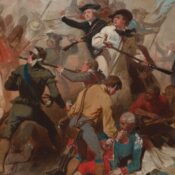Viewed from a half-century away, the outcome of the Vietnam War seems like an inevitability. Surely the U.S. government saw it was wasting money, weapons, and men on a war it couldn’t win.
A major driver of the conflict was the ever-present Cold War and a pervasive fear of the proliferation of communism. American statesmen were desperate to contain its spread in Southeast Asia — and avoid any association with failure. One of these men was Henry Cabot Lodge, the former Massachusetts Senator and ambassador to Vietnam.
In his article in the July 29, 1967, issue of the Post, “We’re Winning in Vietnam,” Lodge explains why, despite what our readers might have heard in other media, the U.S. was making progress in the war.
Lodge points out that the Vietnam War wasn’t like World War II. It had none of the signs of progress of traditional wars. So he explains the “solid achievements” that led the U.S. military to believe it was winning the war:
- South Vietnam now had increased control of the country’s waterways and roads.
- North Vietnam’s supply lines were being disrupted by American bombers.
- Recent elections had been held in South Vietnam despite Viet Cong efforts to disrupt it through terrorist attacks.
- Even the Viet Cong admitted they were losing their grip on the South Vietnamese people.
- “They cannot win,” Lodge confidently declares, “and we cannot be pushed out.”’
What Lodge doesn’t mention is the price America was paying for its gains. The month before this article appeared, 830 Americans had died in combat, and the month before that, 1,223.
And Lodge didn’t know the North Vietnamese and Viet Cong had already begun planning the Tet Offensive, which they launched in January of 1968. It would send 85,000 communist troops in a country-wide assault on five major cities, dozens of military installations, and scores of towns.
When it was over, the North Vietnamese and Viet Cong fell back, leaving 33,000 of their dead behind. It was a tactical defeat for the communists, but it was a psychological defeat for Americans, who saw their combat deaths rise to 1,200 in January and over 2,000 in February. Nearly 17,000 American soldiers died in 1968 alone.
America might have been winning tactical battles, but public support wasn’t there. According to “The U.S. Army in Vietnam” by Vincent Demma, intricate historical, political, cultural, and social factors all played a part in how the war ended: “A new humility and a new sophistication may form the best parts of a complex heritage left to the Army by the long, bitter war in Vietnam.”

Featured image: Photo collage from “We’re Winning in Vietnam” by Henry Cabot Lodge, from the July 29, 1967, issue of the Post.
Become a Saturday Evening Post member and enjoy unlimited access. Subscribe now




Comments
Technically speaking… he was right. ARVN failed in 1975 due to being denied any fuel, ammunition, or air support. It wasn’t plucky guerrillas that overwhelmed them with popular support – by 1975 most South Vietnamese had turned against the communists – it was North Vietnam’s conventional army of Soviet and communist Chinese supplied tanks, driving in columns down through roads built illegally in Laos and Cambodia and brazenly across the DMZ, despite their promises of peace in the Paris Treaty. The ARVN was denied these vital war materials by a hostile American Congress and a neutered president, while they at the same time sent thousands of tons of supplies to Israel. In the end, South Vietnam lost over 200,000 troops fighting the communist invaders; the Americans lost 57,000 troops, and over a million civilians died, all so that a few politicians in America could get elected by hippies. North Vietnamese General Vo Nguyen Giap himself said his “best guerrilla was the American media”. They did immeasurable damage to the world with their skewed reporting of a war they didn’t understand. You’ll notice most high school textbook treatments have little in the way of data and much in the way of misrepresented and out-of-context photographs and paint a very historically distorted picture in line with the journalistic takes of the war. Journalism is often the “first draft of history”, and in this instance, it was a badly written one.
The Ambassador, Henry Cabot Lodge in many ways was extremely knowledgeable about Vietnam and the role the U.S. had played in the war up to that point. I believe HE believed this was a winnable war that would have a positive outcome from what he wrote here.
Such an outcome was not possible, and wouldn’t be in the years ahead. The casualties of American soldiers in Vietnam was already terrible by mid-1967, but circumstances were converging to add terrible fuel to that fire, with things exploding in the U.S. like never before within a year of this feature’s appearance in the Post. Too much to mention here.
It might be easy to write Mr. Lodge off as naive and out of touch and/or be upset or angry with him. 50 years later I appreciate his efforts to understand, try to explain his viewpoint and desire to help a people in a foreign land that needed it.
The bottom line is he meant well. From his photo I see a man who’s very torn and conflicted over a situation he’d never seen the likes of before, and justifiably frightened over this terrible, nightmare riddle with no answers in sight whatsoever. What had worked in the past would not work here. It took Nixon’s intense bombing in December 1972 (unfortunately) to accomplish the end needed there, and another two and a half years for peace and a positive future to take root in Vietnam that we would see today if travelling there.